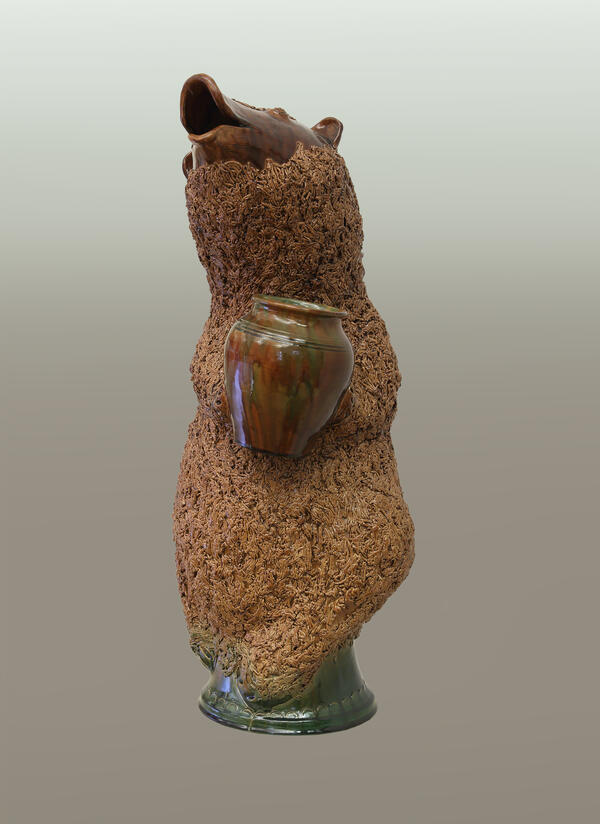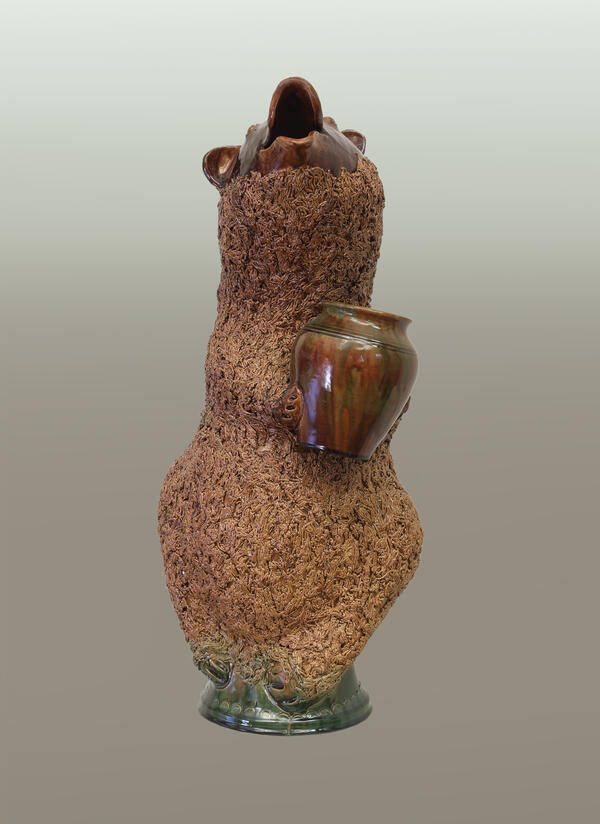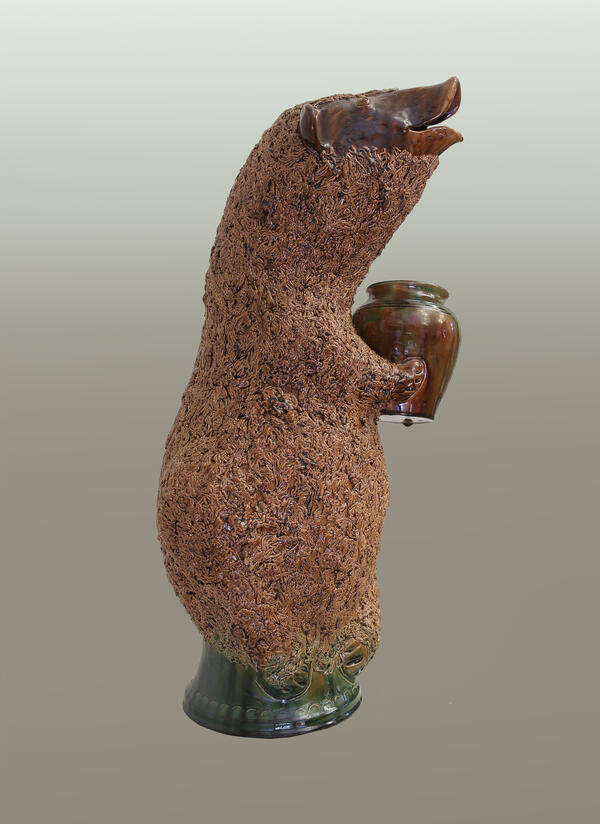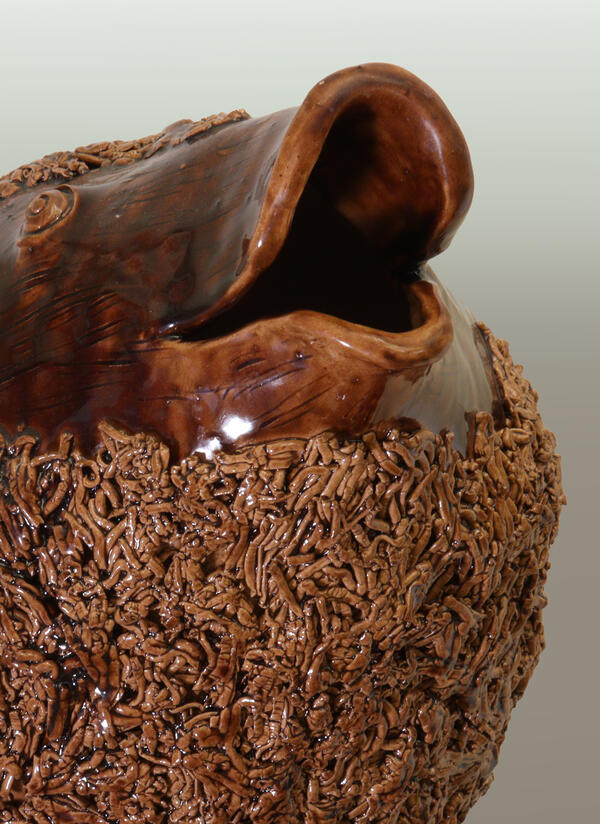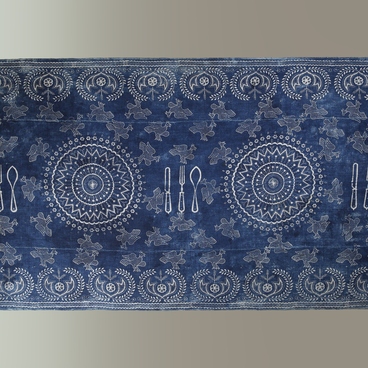The decorative sculpture “Bear” was made in 1994 specifically for the exhibition in the Russian Museum. The author is a hereditary master Sergey Ivanovich Polyakov, who used all the old Skopin pottery techniques when creating this sculpture.
The Skopin census of 1640 has an entry about the Skopin potter Demko Kireev. This is the first mention of the local ceramic production. Skopin ceramics were made on a potter’s wheel or by molding from local light-burning clays. Until the middle of the 19th century, everyday dishes were not glazed.
Polychrome bright glazes appeared in Skopin only in the last third of the 19th century. The color of the transparent vitreous glaze looked intense against a light background. Dark brown glaze included manganese oxide, green — copper oxide, rich yellow — iron oxide. Glaze grains, which were sprinkled on the dishes before firing, melted at high temperatures, spreading into beautiful streaks and specks. This made the products look especially artistic.
In the early 20th century, there were 47 pottery workshops in the small town of Skopin in the Ryazan Governorate. They employed about 200 people. The owners of the workshops advertised their products by displaying their best samples in the windows of the workshop or on pillars at the gates.
Skopin ceramic products with their figured and sculpted vessels stand out among works of other pottery centers. Candlesticks and jugs in the form of a fish, a double-headed eagle, a rooster, a bear with a glass in its paw, and even a monkey were made in parts on a potter’s wheel. It is impossible to find the junction of those details: the products were covered with bright brown, green or yellow ceramic glaze. The surface was adorned underneath with decorative elements: ribbed notches, relief moldings, miniature figures of birds, dogs and even people. In the decorative hole of one kvas jug is the figure of a craftsman working on a potter’s wheel, with his products beside him.
The “Bear” is also made in the form of a vessel, but the artisan created a realistic shape, filled it with movement, and added stucco details: short paws and round ears. The figure is hollow inside, the clay layer is thin, the glaze glistens and shimmers on a smooth surface.
The Skopin census of 1640 has an entry about the Skopin potter Demko Kireev. This is the first mention of the local ceramic production. Skopin ceramics were made on a potter’s wheel or by molding from local light-burning clays. Until the middle of the 19th century, everyday dishes were not glazed.
Polychrome bright glazes appeared in Skopin only in the last third of the 19th century. The color of the transparent vitreous glaze looked intense against a light background. Dark brown glaze included manganese oxide, green — copper oxide, rich yellow — iron oxide. Glaze grains, which were sprinkled on the dishes before firing, melted at high temperatures, spreading into beautiful streaks and specks. This made the products look especially artistic.
In the early 20th century, there were 47 pottery workshops in the small town of Skopin in the Ryazan Governorate. They employed about 200 people. The owners of the workshops advertised their products by displaying their best samples in the windows of the workshop or on pillars at the gates.
Skopin ceramic products with their figured and sculpted vessels stand out among works of other pottery centers. Candlesticks and jugs in the form of a fish, a double-headed eagle, a rooster, a bear with a glass in its paw, and even a monkey were made in parts on a potter’s wheel. It is impossible to find the junction of those details: the products were covered with bright brown, green or yellow ceramic glaze. The surface was adorned underneath with decorative elements: ribbed notches, relief moldings, miniature figures of birds, dogs and even people. In the decorative hole of one kvas jug is the figure of a craftsman working on a potter’s wheel, with his products beside him.
The “Bear” is also made in the form of a vessel, but the artisan created a realistic shape, filled it with movement, and added stucco details: short paws and round ears. The figure is hollow inside, the clay layer is thin, the glaze glistens and shimmers on a smooth surface.

